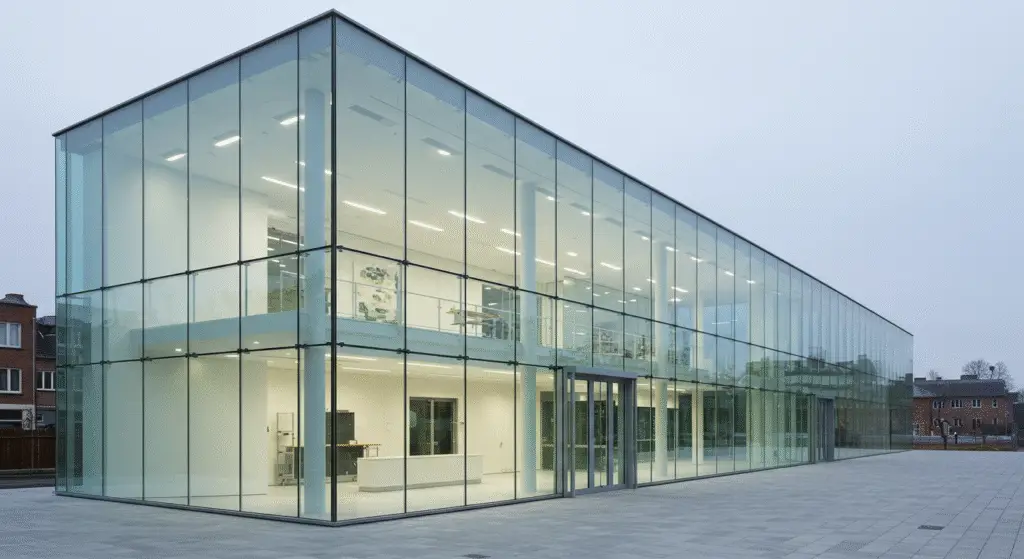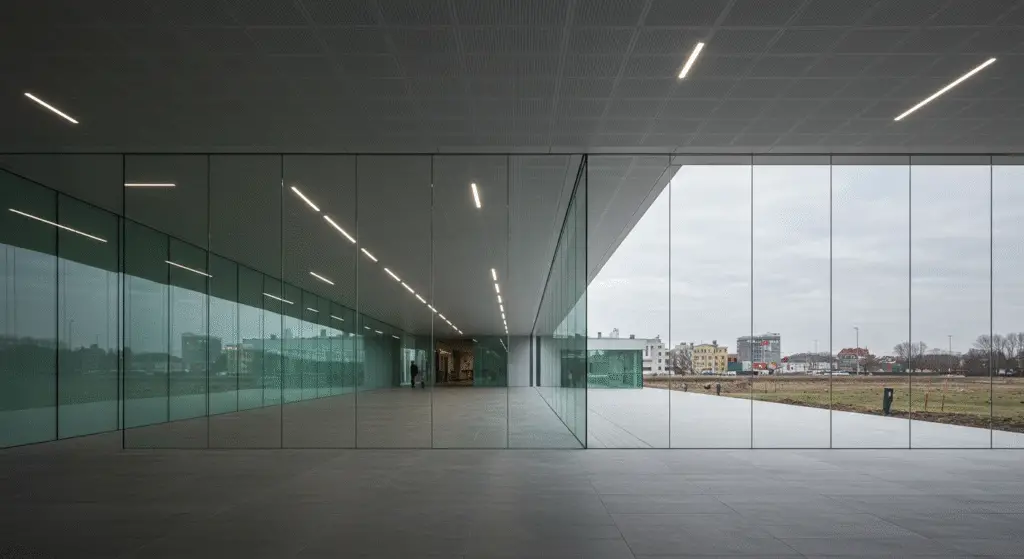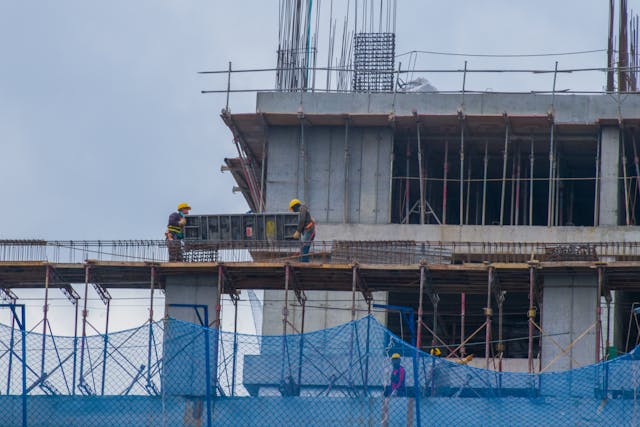What are the different types of structural glazing?

Introduction
Structural glazing has become a cornerstone of modern architecture, offering a blend of functionality, aesthetics, and durability. It is a critical component in the design and construction of buildings, allowing for the creation of large, open spaces with minimal obstruction. Structural glazing refers to the use of glass as a load-bearing element in a building’s structure, providing support and stability while maintaining transparency and light transmission. This article explores the different types of structural glazing, their applications, and the benefits they offer in contemporary architecture.

Understanding Structural Glazing
Structural glazing is a type of glazing system where glass is used not only as a barrier but also as a structural element. Unlike traditional glazing, which is primarily used for fenestration, structural glazing is designed to bear loads and provide support to the building. This includes resisting wind loads, seismic forces, and other external pressures. Structural glazing systems are typically more complex and require careful engineering to ensure their stability and safety.

Types of Structural Glazing
- Frameless Structural Glazing

Frameless structural glazing is one of the most popular types of structural glazing. As the name suggests, this system uses minimal framing, creating a seamless and uninterrupted glass surface. The glass panels are supported by hidden structural elements, such as steel or aluminum frames, which are embedded within the glass or concealed behind it. This type of glazing is ideal for creating modern, minimalist designs with unobstructed views.
- Benefits:
- Aesthetically pleasing and modern appearance.
- Provides unobstructed views and maximum light transmission.
- Suitable for high-end architectural projects.
- Applications:
-Facade systems.
-Roof glazing.
-Interior partitions.
- Framed Structural Glazing

Framed structural glazing systems use visible frames to support the glass panels. These frames are typically made of aluminum or steel and are designed to provide additional strength and stability to the glazing system. Framed structural glazing is commonly used in commercial and residential buildings where a balance between aesthetics and functionality is desired.
- Benefits:
- Provides a classic and timeless appearance.
- Offers excellent structural integrity and durability.
- Suitable for a wide range of applications.
- Applications:
- Curtain wall systems.
- Windows and doors.
- Skylights and atriums.
- Unitized Structural Glazing

Unitized structural glazing systems are pre-fabricated, modular units that consist of glass panels framed by metal or aluminum. These units are assembled in a factory and then installed on-site, reducing construction time and ensuring consistency in quality. Unitized structural glazing is commonly used in high-rise buildings and large-scale commercial projects.
- Benefits:
- Fast installation and reduced construction time.
- High-quality finish and consistency.
- Suitable for large-scale projects.
- Applications:
- High-rise buildings.
- Commercial facades.
- Large-scale residential projects.
- Point-Fixed Structural Glazing

Point-fixed structural glazing systems use individual fixings or fittings to secure the glass panels in place. These fixings are typically made of stainless steel or aluminum and are designed to provide support without the need for a continuous frame. Point-fixed glazing is often used in modern architectural designs where a minimalist and contemporary look is desired.
- Benefits:
- Creates a sleek and modern appearance.
- Provides excellent transparency and light transmission.
- Suitable for complex and unique designs.
- Applications:
-Facade systems.
-Roof glazing.
-Interior partitions.
- Insulated Structural Glazing
Insulated structural glazing systems consist of two or more glass panels separated by a spacer and sealant. This configuration reduces heat transfer and noise, making it ideal for energy-efficient buildings. Insulated structural glazing is commonly used in residential and commercial buildings where thermal performance is a key consideration.
- Benefits:
- Excellent thermal insulation and energy efficiency.
- Reduces noise pollution.
- Suitable for a wide range of applications.
- Applications:
-Facade systems.
-Windows and doors.
-Skylights and atriums.
- Laminated Structural Glazing
Laminated structural glazing systems use multiple layers of glass bonded together with an interlayer material, such as polyvinyl butyral (PVB). This design provides excellent safety benefits, as the glass remains intact even when broken. Laminated structural glazing is often used in applications where security and safety are critical, such as in skylights and overhead glazing.
- Benefits:
- Provides excellent safety and security.
- Reduces the risk of injury from broken glass.
- Suitable for high-risk applications.
- Applications:
-Skylights and overhead glazing.
-Security glazing.
-Impact-resistant applications.
- Double-Glazed Structural Glazing
Double-glazed structural glazing systems consist of two panes of glass separated by a spacer and sealant. This configuration reduces heat transfer and noise, making it ideal for energy-efficient buildings. Double-glazed structural glazing is commonly used in residential and commercial buildings where thermal performance is a key consideration.
- Benefits:
- Excellent thermal insulation and energy efficiency.
- Reduces noise pollution.
- Suitable for a wide range of applications.
- Applications:
-Facade systems.
-Windows and doors.
-Skylights and atriums.
- Triple-Glazed Structural Glazing
Triple-glazed structural glazing systems consist of three panes of glass separated by spacers and sealants. This configuration provides even better thermal insulation and noise reduction compared to double-glazed systems. Triple-glazed structural glazing is commonly used in passive house designs and energy-efficient buildings where maximum thermal performance is required.
- Benefits:
- Excellent thermal insulation and energy efficiency.
- Reduces noise pollution significantly.
- Suitable for high-performance buildings.
- Applications:
-Energy-efficient buildings.
-Passive house designs.
-High-performance commercial projects.
- Smart Structural Glazing
Smart structural glazing systems incorporate advanced technologies, such as electrochromic glass, to provide dynamic control over light transmission and heat transfer. These systems can change their properties in response to environmental conditions, such as light and temperature, offering enhanced energy efficiency and comfort. Smart structural glazing is ideal for modern, high-tech buildings where adaptability and sustainability are key.
- Benefits:
- Provides dynamic control over light and heat.
- Enhances energy efficiency and comfort.
- Suitable for high-tech and sustainable buildings.
- Applications:
-Facade systems.
-Windows and doors.
-Smart buildings and sustainable projects.
- Bent Structural Glazing
Bent structural glazing systems use curved or bent glass panels to create unique and complex shapes. This type of glazing is often used in architectural designs where a curved or rounded appearance is desired. Bent structural glazing is commonly used in skylights, atriums, and other applications where a curved surface is required.
- Benefits:
- Creates unique and complex shapes.
- Provides a modern and aesthetically pleasing appearance.
- Suitable for specialized applications.
- Applications:
-Skylights and atriums.
-Curved facade systems.
-Architectural features and design elements.
Materials Used in Structural Glazing

The materials used in structural glazing systems play a crucial role in their performance and durability. Some of the most common materials include:
- Glass
Glass is the primary material used in structural glazing systems. Different types of glass, such as tempered, laminated, and insulated glass, are used depending on the specific requirements of the application.
- Aluminum Frames
Aluminum frames are commonly used in structural glazing systems due to their strength, durability, and lightweight properties. They provide excellent support for the glass panels and can be customized to suit different design requirements.
- Steel Frames
Steel frames are used in structural glazing systems where additional strength and stability are required. They are commonly used in large-scale commercial projects and high-rise buildings.
- Silicone Sealants
Silicone sealants are used to bond glass panels together and to metal frames. They provide a flexible and durable seal, ensuring that the structure remains watertight and airtight.
- Adhesives
Adhesives play a crucial role in structural glazing systems, particularly in laminated glass. They hold the layers of glass and interlayers together, ensuring that the structure remains intact under various stresses.
- Reinforcing Materials
Reinforcing materials, such as fiberglass or carbon fiber, can be incorporated into glass structures to enhance their strength and stability. These materials are often used in composite glass products where additional structural integrity is required.
Benefits of Structural Glazing

Structural glazing offers a wide range of benefits that make it a popular choice in modern architecture. Some of the most significant advantages include:
- Aesthetic Appeal
Structural glazing provides a sleek and modern appearance that enhances the visual appeal of a building. The use of large glass panels creates a sense of openness and transparency, making it ideal for contemporary designs.
- Natural Light
Structural glazing allows for maximum light transmission, reducing the need for artificial lighting during the day. This not only enhances the aesthetic appeal of the building but also contributes to energy efficiency.
- Energy Efficiency
Many structural glazing systems, such as double-glazed and triple-glazed systems, provide excellent thermal insulation. This reduces heat transfer and minimizes the need for heating and cooling, leading to energy savings and a reduced carbon footprint.
- Durability
Structural glazing systems are designed to be durable and long-lasting. The use of high-quality materials and advanced manufacturing techniques ensures that these systems can withstand various environmental conditions and last for many years.
- Flexibility
Structural glazing systems offer a high degree of flexibility, allowing for the creation of complex and unique designs. Whether it’s a curved facade or a large glass roof, structural glazing can be tailored to meet the specific needs of a project.
- Safety
Structural glazing systems are designed with safety in mind. The use of laminated glass and tempered glass ensures that the system remains intact even in the event of breakage, reducing the risk of injury.
Challenges and Limitations
While structural glazing offers numerous benefits, there are also challenges and limitations to its use. Some of the most significant include:
- Cost
Structural glazing systems can be expensive, especially for specialized or high-performance systems. The cost of materials, manufacturing, and installation can be prohibitive for some projects.
- Maintenance
Structural glazing systems require regular maintenance to ensure their longevity. This includes cleaning, inspecting for damage, and addressing any issues promptly to prevent further deterioration.
- Thermal Stress
Glass expands and contracts with temperature changes, which can lead to thermal stress. This can cause cracking or shattering if not properly addressed in the design and installation of the system.
- Brittleness
Glass is inherently brittle, meaning it lacks the ability to deform plastically under stress. This can lead to sudden and catastrophic failure if the glass is subjected to excessive force.
- Material Compatibility
The compatibility of materials used in structural glazing systems must be carefully considered to ensure that there is no adverse reaction or degradation over time. This includes the compatibility of glass with metal frames, sealants, and adhesives.
Case Studies: Famous Structural Glazing Applications
Examining real-world applications of structural glazing provides valuable insights into its practical uses and benefits. Some notable examples include:
- The Crystal Palace, London
The Crystal Palace, built for the Great Exhibition of 1851, was a pioneering structure that showcased the potential of glass in architecture. Its large glass and iron frame demonstrated the feasibility of using glass in grand-scale structures.
- The Guggenheim Museum, Bilbao
The Guggenheim Museum in Bilbao, Spain, features extensive use of structural glazing in its atrium and skylights. The flowing curves of the glass design create a sense of fluidity and space, while maintaining structural integrity.
- The Apple Park, Cupertino
Apple Park, the headquarters of Apple Inc., incorporates large glass panels and domes in its design. The use of structural glazing allows for an open and airy interior, while the glass’s strength and durability ensure the structure’s stability.
- The Shard, London
The Shard, one of the tallest buildings in Europe, features a sleek and modern glass facade that provides stunning views of the city. The structural glazing system used in The Shard is designed to withstand various environmental conditions, including wind and seismic activity.
- The Burj Khalifa, Dubai
The Burj Khalifa, the tallest building in the world, features a double-layered structural glazing system that provides excellent thermal insulation and energy efficiency. The system is designed to reduce heat transfer and minimize the need for air conditioning in the hot desert climate.
Future Trends and Innovations
The future of structural glazing is promising, with ongoing research and development focused on improving its properties and expanding its applications. Some potential trends and innovations include:
- Advanced Glass Materials
The development of new glass materials with enhanced strength, flexibility, and thermal resistance could revolutionize structural glazing applications. These materials may include nanomaterials, smart glasses, and advanced composites.
- Energy-Efficient Glazing
There is a growing emphasis on energy efficiency in building design. The development of energy-efficient glazing systems, such as triple-glazed and smart glazing, could play a significant role in reducing energy consumption and enhancing building performance.
- 3D Printing and Digital Fabrication
Advancements in 3D printing and digital fabrication techniques could enable the creation of complex glass structures with unprecedented precision and efficiency. This could lead to innovative and cost-effective solutions for structural glazing applications.
- Integration with Smart Technologies
The integration of smart technologies into structural glazing systems could offer new functionalities, such as self-cleaning surfaces, adaptive shading, and real-time monitoring of structural health. These technologies could enhance the performance and sustainability of glass structures.
- Sustainable and Green Building Practices
There is a growing emphasis on sustainable and green building practices in the construction industry. Structural glazing systems that incorporate recycled materials, reduce energy consumption, and minimize environmental impact will play a crucial role in the development of sustainable buildings.
Conclusion
Structural glazing is a versatile and dynamic material that has transformed the way we design and construct buildings. From frameless and framed systems to unitized and point-fixed glazing, there are numerous types of structural glazing systems to choose from, each with its own unique benefits and applications. By understanding the different types of structural glazing and their properties, architects and engineers can create innovative and functional designs that meet the demands of modern architecture.
As we look to the future, the continued development of new materials and technologies will undoubtedly expand the possibilities of structural glazing. Whether it’s through the creation of advanced glass materials, the integration of smart technologies, or the adoption of sustainable building practices, structural glazing will remain at the forefront of architectural innovation. By embracing these advancements and pushing the boundaries of what is possible, we can create buildings that are not only functional and efficient but also aesthetically pleasing and inspiring.
In conclusion, structural glazing is more than just a material; it is a tool for creating spaces that inspire, connect, and enhance our daily lives. As we continue to explore the possibilities of structural glazing, we will uncover new ways to use this versatile material to build a better and more sustainable future.

What are the different types of structural glazing?
Structural glazing is designed to bear loads and provide support to the building.
Pingback: What are some examples of things structural engineers design? – worldcivilsociety.com
Pingback: The Highest Salary for a Structural Engineer: A Comprehensive Overview – worldcivilsociety.com
Pingback: How to Choose the Right Façade Glazing for Your Building
Pingback: Glazing System Installation: Expert Tips for Success
Pingback: Unlocking the Secrets of Smart Glass Engineering
Pingback: Structural Glass Canopy Design: Elevate Your Outdoor Spaces
Pingback: Glazing System Installation Best Practices